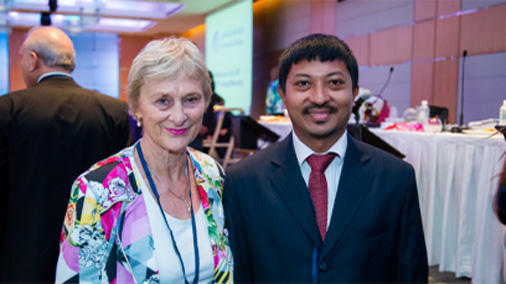
This photograph inspires me each time I see it. It is of two great physiotherapy leaders: Gillian Webb, immediate past Chair of the AWP Region, and Nishchal Shakya, President of the Nepalese Physiotherapy Association (NEPTA).
In the photograph, both look engaged and relaxed at the General Meeting in Singapore in April 2015, just before the WCPT Congress. It is hard to believe that two days before, Nishchal was in his home in Nepal when an earthquake struck the country.
Nishchal described his feelings. "It was really a difficult and terrifying moment," he says. "I felt like this is the end of life… I had to secure my family, and I was especially worried about my four-month-old daughter. We had to stay outside, day and night, in the courtyard in a little open space."
Having been very excited about attending the General Meeting and Congress, he was overcome with conflicting emotions; representing Nepal at the meeting, and the pressure of not wanting to leave his family and relatives at a crucial time.
Gillian reached out to Nishchal, and with the support of his family, he made arrangements to attend. I don’t know how he managed. Packing and rearranging travel in the midst of aftershocks and disrupted communications networks. The WCPT AWP Region sorted out accommodation for Nishchal in Singapore, as this had also been disrupted.
Nishchal recounts how he felt in Singapore. "When I was in the meeting, I used to feel that the building was shaking. If somebody moved the table I felt it as an earthquake. I also happened to ask a few people if they felt shaking and they would say, 'No, no - it isn't shaking. Please relax, go outside the meeting hall if you want to divert and relax your mind. See things around, you shall be fine…'
"Though I was physically in Singapore, I was mentally at home thinking about my family and my people."
The global PT community
However, the support of the global PT community at Congress gave Nishchal great encouragement. Back at home there was a surge of patients at government hospitals, especially in the capital city Kathmandu.
NEPTA sought volunteer PTs via social networks during the initial days of the earthquake. They worked with government health facilities, non-governmental organisations and foreign medical teams in the rehabilitation sub-cluster system.
This was operated under the Ministry of Health, and was established to map injuries, rehabilitation needs and to facilitate service delivery. NEPTA assisted in the advertising and timely recruitment of local physiotherapists to areas of identified need through its well-established social media network.
NEPTA’s knowledge, and database of local physiotherapy resources, allowed them to mobilise personnel before requesting international expertise in specialised areas identified as gaps in service provision.
Nishchal is quiet and very humble when describing his leadership, which has enabled NEPTA to reach new heights of achievement at national and international level.
"For all this to happen it is not only one person who plays a role, but the whole team," he says. "And I think it also depends on how you form your team.
"I had spent a lot of time thinking and making a good team for NEPTA, well before I became the elected president, and after becoming the president. It is really difficult and challenging to select and prepare people who are all just voluntarily working, and to manage to get the best out of what they have. Besides that, I have, as a leader, now well realised that the preparation of future leaders is also very important, to retain the achievements and further take the profession ahead in future."
Building resilience
Resilience in individuals and communities is a very common theme these days. Most of us haven't had to experience an earthquake to make the kind of decision Nishchal had to make. Then, to work with his community in the service of people who have been injured, and at the same time develop the profession, is astonishing.
Nonetheless, many of us face personal and professional challenges. Understanding resilience, and how to develop it, can be key. We seek resilience for ourselves and for patients, clients, students and the teams and organisations in which we participate and practice.
The American Psychological Association states that resilience is 'the process of adapting well in the face of adversity, trauma, tragedy, threats or significant sources of stress. It means "bouncing back" from difficult experiences. Research has shown that resilience is ordinary, not extraordinary’.
In an article called Resilience in Positive Psychology: Bouncing Back & Going Strong, Nwiran & Pennock (2017) suggest that ‘being resilient is not a trait, but more a dynamic learning process.' They describe strategies for building resilience, including the following:
- Identify and leverage your strengths
- Learn to perceive obstacles as challenges rather than hindrances
- Focus on progress, not goals
In a WCPT news story shortly after the earthquake, Nishchal described how the community was trying to bounce back. The ongoing leadership shown by Nishchal and colleagues in Nepal has resulted in physical therapy being included as part of the Basic Health Package in the national Health Strategy for 2016-2021. They continue to advocate successfully for physical therapy and rehabilitation policies and strategies to be included in the Health Directives of Nepal.
Related links
- American Psychological Association: The Road to Resilience
- Resilience in Positive Psychology: Bouncing Back and Going Strong

